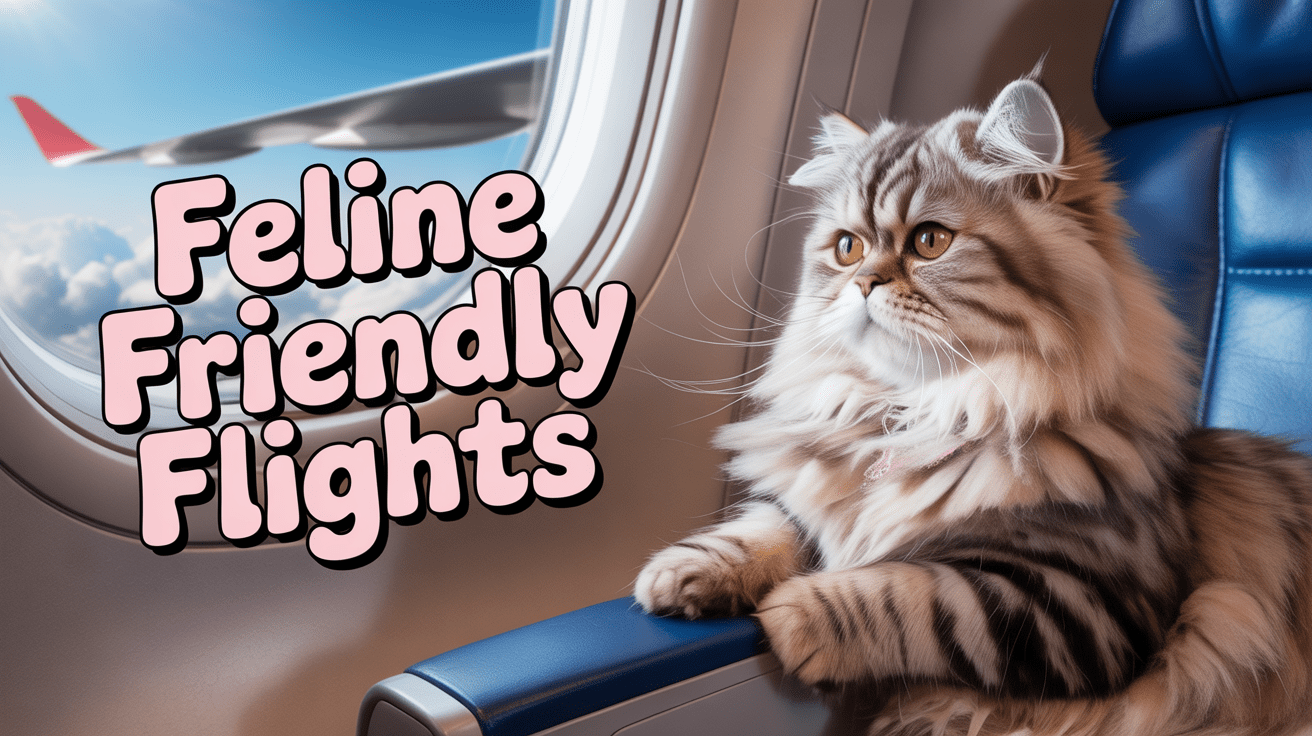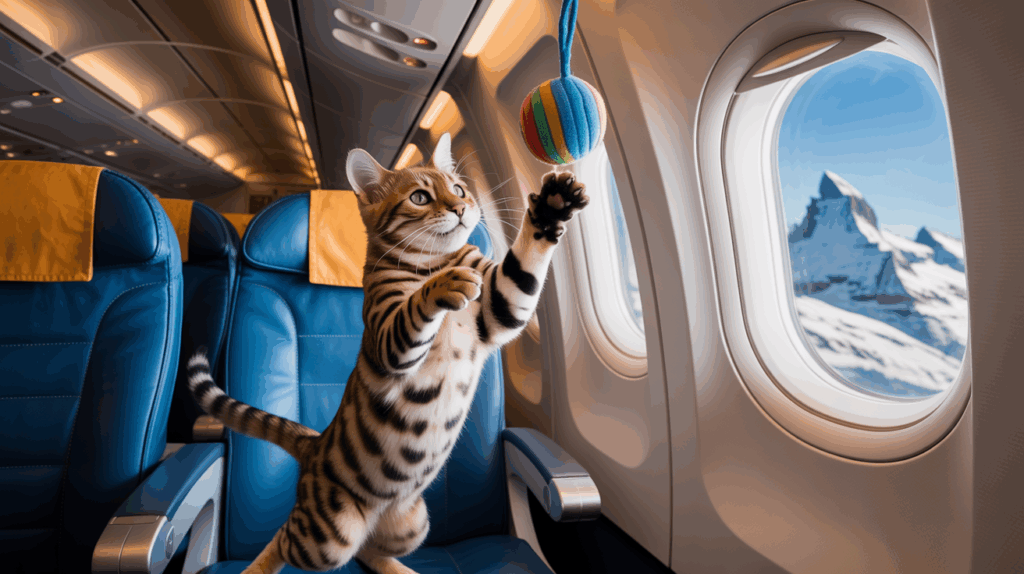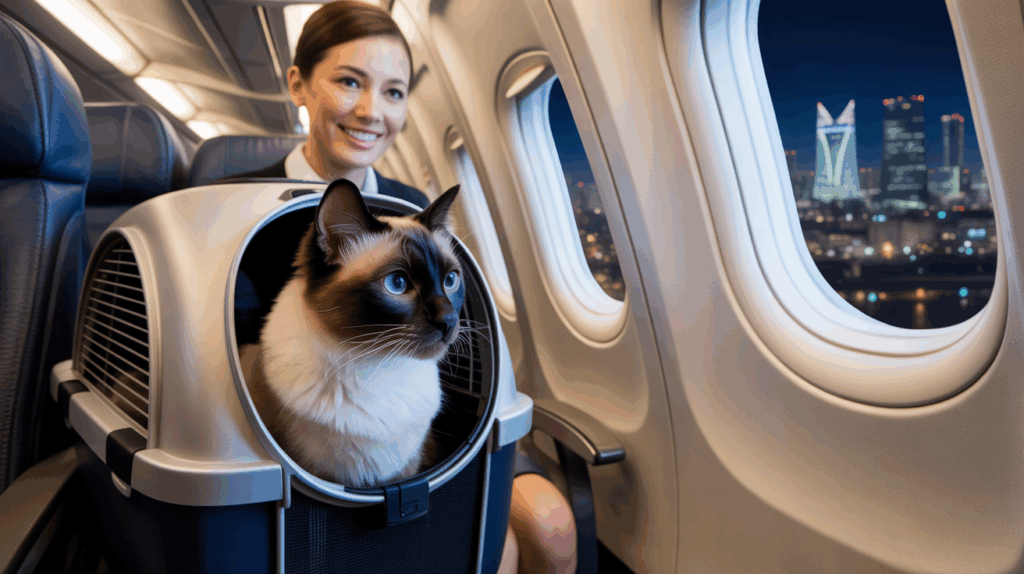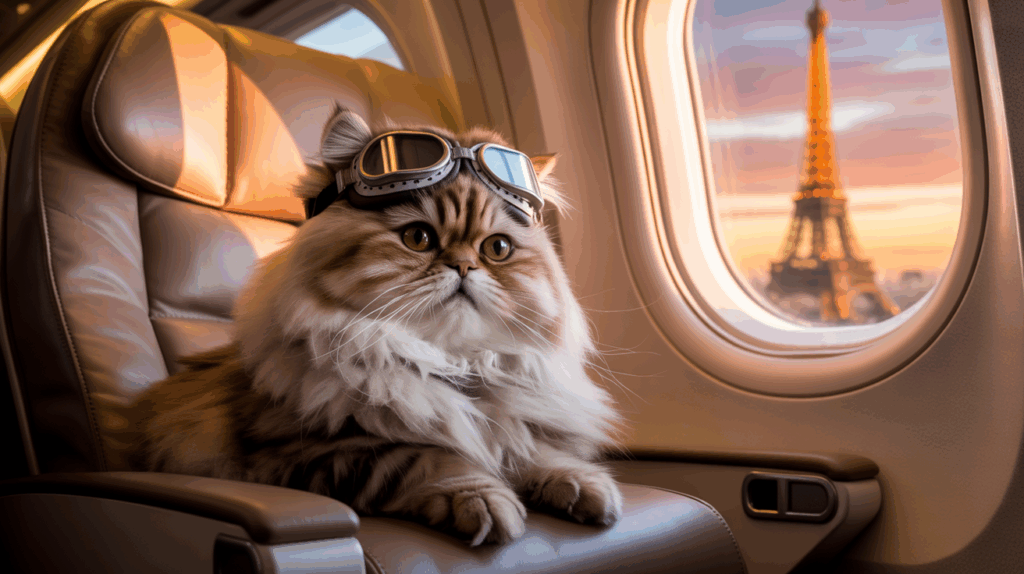
Newsletter Subscribe
Enter your email address below and subscribe to our newsletter

Enter your email address below and subscribe to our newsletter

Perhaps you’re visiting someone in another country or just trying to go on a vacation. And you are determined to bring your cat along. But it’s so overwhelming seeing that each airline seems to have a different rulebook.
Are there international airlines that allow cats in cabin? Fortunately for you, your cat can fly with you on international flights. But remember that the fine print matters.
A good number of airlines cap the combined weight of both your cat and their carrier at 15-20 pounds. You may also need to pay a fee of $100 to $300 for every flight segment. Also, most airlines cap the number of cats you can bring along in the cabin.
Now, note that you shouldn’t assume that all international airlines that allow cats in cabin follow the same rules. This can turn out to be a costly mistake. Lufthansa and Air France, for example, have clear, detailed pet policies. You just need to read them on their websites.
Some other airlines, however, may be less clear and may only allow you to bring two cats in-cabin. But that is only if they fit comfortably in the carrier.
If you happen to be a frequent traveler and love bringing your cat everywhere, vets recommend that you do carrier training with your cat early to help them get comfortable with the long-haul flight. You might also need some calming aids to help you.
Now, let us continue reading and learn about the requirements for flying with your cat. It could ultimately mean the difference between a smooth journey and being turned away at check-in.
Looking for a quick answer? Here are the international airlines most often listed as ‘cat-friendly’ for 2025 cabin travel based on policy clarity, fees, and flexibility.

If you see an airline saying that they allow cats in cabin, it means they have a policy that allows you to bring your feline friend with you into the passenger area. You’re not leaving them in the cargo hold.
This is quite an appealing option for many of us pet owners. It helps reduce your cat’s stress level and keeps them within your view. You can then respond to and directly care for your cat during the flight.
Cargo travel, on the other hand, is unpredictable. Your pet will need to be handled by staff, and they may not know the nuances of taking care of each animal. And you might not be able to relax on your way to your destination.
Now, don’t assume that all airlines that permit cats in the cabin follow universal rules. There are usually strict policies in place regarding your cat’s carrier size, the combined weight limits, and the exact spot where your animal friend can be placed during the flight.
Charges usually come with bringing your cat along. Note that most airlines charge additional fees per flight segment (“per leg” if you’re more familiar with this term). And these costs can vary widely between different international airlines. So, do your research and budget carefully.
Vets do recommend that we bring our cats along in the cabin to monitor their health and stress levels. After all, our feline companions are sensitive to temperature fluctuations and noise (especially during takeoff). And these can be hard to control in cargo areas.

If you want to bring your cat along in the cabin on an international trip, the first thing you need to be clear on is the airline requirements. It’s probably just as important or even more important than buying your tickets.
Most airlines that allow cats in cabin for international routes have detailed, non-negotiable policies. So, there’s no chance of arguing your way through.
Now, many airlines have set clear guidelines around your pet carrier’s dimensions. More often than not, the carrier must fit entirely under the seat right in front of you. In general, the size should not exceed about 18 x 11 x 11.
The weight limit is also something you need to take note of. Usually, there’s a set limit for the combined weight of both your cat and their carrier at 15-20 pounds. Don’t assume that your “small” cat will just pass the weight check. Measure both the carrier and your cat earlier so that you won’t be turned away at the last minute.
International airlines usually charge between $100–$300 for in-cabin pets per flight segment. And this fee is often non-refundable. That means if your cat is denied at the gate for not meeting any requirements, you’re not getting your money back.
Frequent flyers say that we should confirm all the conditions before buying the tickets and call again 72 hours before departure to reconfirm the details.
Beyond the rules, vets recommend that we prepare our cats for the journey. You should get your cat used to being in their carrier weeks in advance. Try consistent “practice sessions” at home. This can reduce stress-related issues during your flight.

Different international airlines treat in-cabin cat travel differently. Each usually sets their own policies on weight limits, carrier size, and fees. So, compare them and find the airline that suits you most before you purchase your tickets.
Lufthansa is an airline that’s consistent with their pet travel program. They permit your small cat (one cat) to ride in the cabin with you as long as your feline friend is under 8 kg (about 17 lbs), including the weight of your cat’s carrier. And the recommended measurements for a carrier are 22 × 16 × 9 in.
Air France, on the other hand, does allow in-cabin cats (usually one cat per person) with the same weight requirements. But note that your carrier will need to be slightly smaller (18 x 11 x 9 in.).
Delta, while primarily U.S.-based, does offer some international service. But note that it is rather limited, and you’ll need to meet the documentation requirements. In-cabin services are rare. Be aware that Delta has a rule against pets as checked baggage.
Emirates generally does not allow pets in the cabin unless they are service dogs. And even then, there are restrictions on the routes they can be on. Your cat will have to travel in the cargo hold.
Cost structures also differ dramatically across different airlines. For example, Air Canada usually charges around $100–$120 per one-way international flight. European airlines might charge around €75–€150.
And if you have two cats with you, you’ll need to choose airlines that allow 2 cats in-cabin. Certain policies from KLM or TAP Portugal do allow your cats to share one carrier.
That said, you’ll need to book early because most airlines limit the number of animals on the aircraft per flight. So, make sure you do some detailed research.
| Airline | Pets in Cabin? | Max Weight (Pet + Carrier) | Max Carrier Size | Fee (USD) | Max Pets per Person | 2025 Policy Notes |
| Lufthansa | Yes | 8 kg / 17.6 lbs | 55 × 40 × 23 cm (22 × 16 × 9 in) | $72–$120 | 1 | Must register 72 hrs before flight |
| Air France | Yes | 8 kg / 17.6 lbs | 46 × 28 × 24 cm (18 × 11 × 9 in) | $100–$200 | 1 | Only soft carriers allowed |
| KLM | Yes | 8 kg / 17.6 lbs | 46 × 28 × 24 cm (18 × 11 × 9 in) | $75–$400 | 1 | 2 cats allowed if <14 kg each & same litter |
| Air Canada | Yes | 10 kg / 22 lbs | 55 × 40 × 27 cm (21.5 × 15.5 × 10.5 in) | $50–$100 | 1 | From June 2025, only soft carriers allowed |
| Delta | Limited | ~9 kg / ~20 lbs | 46 × 28 × 28 cm (18 × 11 × 11 in) | $95–$200 | 1 | Few international cabin routes available |
| United Airlines | Limited | No fixed limit | 46 × 28 × 28 cm (18 × 11 × 11 in) | $125 | 1 | Depends on space availability |
| JetBlue | Yes | 9 kg / 20 lbs | 43 × 32 × 22 cm (17 × 12.5 × 8.5 in) | $125 | 1 | International rules updated in 2024 |
| Emirates | No | N/A | N/A | N/A | N/A | Only guide dogs allowed in cabin |
| Qatar Airways | Limited | Not specified | Not specified | Varies | 1 | Mostly cargo or checked baggage |
| TAP Portugal | Yes | Not specified | Very short height (17 cm) | Varies | 1 | Allowed only if pet fits comfortably |
Now, beyond meeting the requirements and booking your flight tickets, you’ll likely need to provide documentation regarding your cat. These usually include health records, permits, and airline-approved documents. Understand that airlines that allow cats in cabin for international routes are strict with these rules.
At minimum, most international airlines will need you to provide a vet health certificate. And this should be issued 7–10 days before your departure. This document will help the airlines confirm that your cat is healthy and does not carry any contagious diseases, meaning they are fit to travel.
You’ll likely need to prove that your cat has taken rabies vaccinations. Some countries may need your cat to take additional vaccines or blood tests. For example, the European Union requires your pet to take the rabies antibody titration (titer) test. The same applies to Japan.
Understand that the costs can add up rather quickly. You’ll need to set up vet appointments, pay for vaccinations, and secure your cat’s government-endorsed certificates. Be ready to spend at least $150-$500, depending on where you live, of course.
Also, some destinations like Australia, Singapore, or the United Kingdom may need you to show import permits. Your cat might even need to spend some time in quarantine before being allowed in the country.
Vets suggest that you should plan in advance. It can take weeks to process documents like permits. So, visit your vet at least two months before your flight to create a checklist for the chosen airline.
You’re probably checking with your friends and watching YouTube videos regarding flying in the cabin with your cat. Now, some advice may be genuine. But that doesn’t make it foolproof across all international airlines that allow cats in cabin. So, learn to check the facts.
One widespread myth that’s circulating is that “all cats are automatically allowed in cabin” as long as the airline permits cats in the cabin. That’s not usually the case. Most airlines do have a weight limit for your cat plus their carrier. So, your large feline friend will likely need to travel as baggage or in cargo. It doesn’t matter how tame they are.
Another misconception is that you can bring multiple pets freely. Well, you may find that there are airlines that allow 2 cats in-cabin in a shared carrier. But this is only permitted if your feline companions are comfortable enough. And the combined weight will still need to stay within the limit.
Some of us also believe that a pet fee is included in the ticket. That’s not usually the case. Most airlines will almost always charge you separately. And remember, the cost is usually per international segment.
Also, vet experts mention that traveling in-cabin doesn’t mean it’s stress-free for your cat. It is safer than cargo, no doubt. But your cat may still feel anxious from the noise and changes in air pressure. There’s also the unfamiliar surroundings. So, bring a pheromone spray and provide your cat with familiar bedding to keep them calm.
6–12 Months Before Flight
3–6 Months Before Flight
1 Month Before Flight
10 Days Before Flight
Day of Flight
Having to endure the long flight is definitely a call for anxiety, both for you and your cat. Choosing international airlines that allow cats in-cabin is the first step to mitigating such an issue. And with some strategies, you will be able to handle the trip with minimal stress and maximum security.
So, the first step is to prepare your cat’s carrier. Make sure that it is well-ventilated and airline-approved. You should also make sure that the bedding is absorbent. Acclimate your cat to the carrier weeks in advance. Get them to feel comfortable being in there gradually. You don’t want them to protest mid-flight in loud meows.
Experts say that you can just leave the carrier open at home at the beginning of training. Place some treats and toys in the carrier. You can even put a familiar blanket inside to help your cat think that the carrier is a safe space.
You will also need to be aware of hydration and feeding. Most vets suggest you feed just a small meal a few hours before your flight, no large meals. This is to prevent your feline friend from feeling nauseated. For long-haul flights, you can freeze a small dish of water. Let it melt gradually as the source of hydration so that your little one won’t spill the liquid.
You may also need calming aids to manage your cat’s stress level. You can try pheromone sprays like Feliway or use natural remedies such as lavender-scented blankets. Do not use sedatives on your feline without your vet’s approval. They can affect your cat’s breathing under cabin pressure.
It’s easy to get drowned by the sheer number of policies out there when you’re trying to travel internationally with your feline companion. To help you prepare, we’ve gathered some of the most frequently asked questions about international airlines that allow cats in cabin.
Most airlines will need you to provide a vet health certificate, proof of vaccinations, and an airline-approved carrier. You should book your cat’s spot in advance since airlines limit the number of pets per flight.
You can check out Lufthansa, Air France, and Delta. They usually have very transparent pet travel policies and reasonable in-cabin fees.
Many major carriers allow cats in the cabin. These include United Airlines, KLM, Air Canada, etc. The rules on weight and carrier size vary, though.
Lufthansa and Air France are possibly the most cat-friendly. They have consistent policies, staff training, and a good pet care reputation.
Yes, your cat can fly in the cabin on international flights. But you have to make sure to meet airline-specific requirements for weight, health, and carrier dimensions.
Most international airlines charge $100–$300 per one-way flight. Fees will vary depending on the carrier and destination.
You’ll need a recent vet health certificate and proof of rabies vaccination. In some cases, you’ll even need additional permits, depending on the destination country.
Typically, airlines allow each passenger to bring only one cat. However, there are airlines that allow 2 cats in-cabin. But your feline companions will have to share one carrier and meet the weight limit.
Yes. The combined weight of the cat and carrier usually cannot exceed 15–20 pounds on most international airlines.
If your cat exceeds cabin weight or carrier limits, they will need to travel as checked baggage or cargo. You should research airline safety records if you’re thinking of choosing this option.
Yes, you can bring your cat along on trips and vacations. But success will depend on your meeting the airline requirements. Remember to weigh your cat and their carrier much earlier before your flight so that you can counter the set weight limit.
You should budget for a fee of around $100–$300 per flight segment. And book early to make sure that there’s space for your pet. Also, compare airline policies and see which one suits you the best, especially if you’re travelling with multiple cats.
Other than that, you should prepare your cat for the flight by acclimating them to their carrier. Use calming aids if needed. But do not give them sedatives without professional guidance.
With the right planning, you can be sure that your journey with your pet is a safe and comfortable one. It’s always better to travel stress-free and land at your destination with confidence and excitement.
Have you flown with your cat in the cabin before? Which airline do you like best? Share your thoughts in the comments down below!